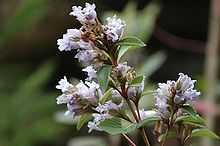Strobilanthes kunthiana
| Strobilanthes kunthiana | |
|---|---|
 | |
| Scientific classification | |
| Kingdom: | Plantae |
| (unranked): | Angiosperms |
| (unranked): | Eudicots |
| (unranked): | Asterids |
| Order: | Lamiales |
| Family: | Acanthaceae |
| Genus: | Strobilanthes |
| Species: | S. kunthiana |
| Binomial name | |
| Strobilanthes kunthiana (Nees) T. Anderson | |
Neelakurinji (Strobilanthes kunthiana) (Malayalam: നീലക്കുറിഞ്ഞി) (Tamil: நீலக்குறிஞ்சி), is a shrub that used to grow abundantly in the shola grasslands of the Western Ghats in South India above 1800 metres. The Nilgiri Hills, which literally means the blue mountains, got their name from the purplish blue flowers of Neelakurinji that blossoms gregariously only once in 12 years. The Paliyan tribal people apparently used it to calculate their age.[1]
This plant belongs to the genus Strobilanthes which was first scientifically described by Christian Gottfried Daniel Nees von Esenbeck in the 19th century. The genus has around 250 species, of which at least 46 are found in India. Most of these species show an unusual flowering behaviour, varying from annual to 16-year blooming cycles; on the national scale there is often confusion about which plant is flowering.[2]
Plants that bloom at long intervals like Strobilanthes kunthiana are known as plietesials. Other commonly used expressions or terms which apply to part or all of the plietesial life history include gregarious flowering, mast seeding, and supra-annual synchronized semelparity (semelparity = monocarpy).[3]
Description
Neelakurinji is the best known of a genus, Strobilanthes, that has flowering cycles ranging from one to 16 years. Besides the Western Ghats, Neelakurinji is seen in the Shevroys in the Eastern Ghats. It occurs at an altitude of 1300 to 2400 metres. The plant is usually 30 to 60 cm high on the hills. They can, however, grow well beyond 180 cm under congenial conditions.[4]
Masting
Some species of Strobilanthes including this one are examples of a mass seeding phenomenon termed as masting[5] which can be defined as "synchronous production of seed at long intervals by a population of plants".[6] Strict masting only occurs in species that are monocarpic (or semelparous) -- individuals of the species only reproduce once during their lifetime, then die,[7] as is the case with Strobilanthes kunthiana.
Habitat
They once used to cover the Nilgiri Hills and Palani Hills like a carpet during its flowering season. Now plantations and dwellings occupy much of their habitat. In 2006, Neelakurunji flowered again in Kerala and Tamil Nadu after a gap of 12 years. Apart from Nilgris, Neelakurinji grow in grass lands of Eravikulam, hills between Klavarai in Tamil Nadu and Vattavada, near Munnar in Kerala during the season from August to December.
Conservation
Kurinjimala Sanctuary protects the kurinji approximately 32 km² core habitat of the endangered Neelakurinji plant in Kottakamboor and Vattavada villages in Devakulam Taluk, Idukki district of Kerala, The Save Kurinji Campaign Council organises campaigns and, programmes for conservation of the Kurinji plant and its habit.[4]
References in literature
The Kurinji flower and the associated mountainous landscape where it blooms was used in classical Tamil literature (Sangam literature) as a symbol for the union of lovers (See Sangam landscape). The famous poetic fragment "Red Earth and Pouring Rain" from the Kuruntokai makes an indirect reference to the flower.
See also
References
- ↑ Mike Kielty, Thursday Online, The Lost Gardens of the Raj (2008-3-4)
- ↑ Kurinji crown - The Palni Hills are once again witnessing the mass flowering of neelakurinji.; TEXT & PHOTOGRAPHS by IAN LOCKWOOD; Volume 23 - Issue 17 :: Aug. 26-Sep. 08, 2006; Frontline Magazine; INDIA'S NATIONAL MAGAZINE from the publishers of THE HINDU
- ↑ Daniel, Thomas F. 2006. Synchronous Flowering and Monocarpy Suggest Plietesial Life History for Neotropical Stenostephanus chiapensis (Acanthaceae). Proceedings of The California Academy of Sciences. Fourth Series. Volume 57, No. 38, pp. 1011–1018, 1 fig. December 28, 2006
- ↑ 4.0 4.1 Save Kurinji Campaign, Flower of the blue mountains]
- ↑ Kelly, D. 1994. The evolutionary ecology of mast seeding (PDF). Trends Ecol. Evol.. 9(12): 465-470. Accessed on 24 January 2010
- ↑ Janzen (1976) in Annul. Rev. Ecol. Syst., 7, 347-391
- ↑ Strobilanthes callosus; Botany Photo of the Day; Notes posted by Daniel Mosquin; January 13, 2009
- Sharma, MV et al. 2008. Reproductive strategies of Strobilanthes kunthianus, an endemic, semelparous species in southern Western Ghats, India. Botanical Journal of the Linnean Society. 157:155-163. doi:10.1111/j.1095-8339.2008.00786.x.
- Kurinji crown - The Palni Hills are once again witnessing the mass flowering of neelakurinji.; TEXT & PHOTOGRAPHS by IAN LOCKWOOD; Volume 23 - Issue 17 :: Aug. 26-Sep. 08, 2006; Frontline Magazine; INDIA'S NATIONAL MAGAZINE from the publishers of THE HINDU
- Kurinji rules the hills - The latest instance in the 12-yearly flowering cycle is a big draw; by K.P.M. Basheer; Sep 13, 2006; The Hindu, Online edition of India's National Newspaper
- A Revision of the Strobilanthes kunthiana-Group (Phlebophyllum sensu Bremekamp) (Acanthaceae). Mark A. Carine, Jake M. Alexander and Robert W. Scotland. Kew Bulletin Vol. 59, No. 1 (2004), pp. 1-25